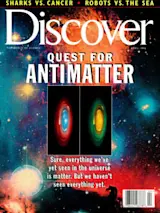Albert Manqué is a physicist of the old school. Fifty years ago physicists could make experiments using material from the hardware store, says Manqué, who works at the Centre de l’Étude des Choses Assez Minuscules in Paris. I too prefer to work on a small scale. His penchant for tabletop research recently paid off. He and a colleague at the center have discovered an extraordinary new fundamental particle. Although the particle exists for just millionths of a second, it is the size of a bowling ball. Its existence, says Manqué, could possibly explain a host of mysterious phenomena.
Manqué and his colleague Jean-Xavier Zweistein call the new particle a bigon and say its discovery was serendipitous. Their main research consists of building better vacuum tubes to replace microchips. We are the only physicists in the world working on that, more or less, says Manqué. They were running a large current through one of their tubes when the monitor of a nearby desktop computer exploded.
We thought it was an accident completely from the blue sky, says Manqué. The computer was connected to an entirely separate electric circuit, so it should not have been affected. But after we bought a new one and ran current again through the tube, the new computer, it too exploded. The physicists set up a video camera and repeated the experiment--with the same explosive results. In one of the video frames a black bowling-ball- size object hovered above the wreckage of the computer. In the next frame it was gone.
The researchers believe that the electric field in the vacuum tube somehow altered the energy state of the vacuum inside the cathode-ray tube in the nearby computer monitor. No vacuum is truly empty--virtual particles, most of them quite small, continually burst into existence and then dissolve back into the void. The physicists believe that they accidentally generated an electric field of just the right size in the computer to nudge a new particle--a bigon--into being.
They have since detected bigons in a specially built cloud chamber--a gas-filled detector that traces particle paths. The bigon leaves a unique signature, says Manqué. Indeed, he thinks the new particle’s signature may be everywhere in nature. Bigons could be responsible for ball lightning, migraines, the unexplained failures of equipment and soufflés, the spontaneous human combustion--I don’t know, maybe earthquakes even, Manqué says. An archeologist colleague here at the center believes a bigon may also have brought down the walls of Jericho. You know that story, too, has never been explained to our satisfaction.
Is there any chance that the bigon is just a figment--or some kind of ridiculous April Fool’s joke, as virtually all other physicists are saying? People are so cynical, responds Zweistein. Science, he points out, routinely produces findings that seem too marvelous to be believed-- and that yet turn out to be true. Tripping dinosaurs, surfing clams--is a somewhat large particle more unbelievable than that? Or are you saying we ourselves have been duped? That I don’t think. Subtle is the Lord, but he is not a kegler.














